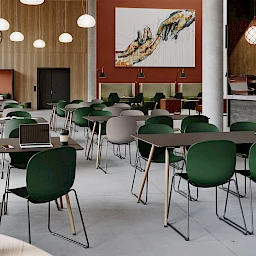More and more companies are recognising the value of a good working atmosphere. In order for offices to remain attractive for employees, it will be important to create a setting in which everyone feels comfortable and at ease – and can be productive. Keyword: corporate hospitality. The IBA Forum editorial team discusses with Robert Thiemann, founder and publisher of the interior design magazine FRAME, how hospitality can be implemented in interior design and what the office can learn from the restaurant and hotel industry.
People like to spend time in places that welcome them in a friendly way and offer them a high quality of stay. How comfortable can employees currently feel in their offices?
People can feel very comfortable in an office if it has specific qualities. We are talking here primarily about the quality of stay. In other words, a range of spaces and designs that enable cross-departmental collaboration, where good meetings can be held and where colleagues can get together for a meal. A diversity of atmospheres and meeting types is what makes spaces with a high quality of stay. Unfortunately, not all offices possess these qualities at the moment. But it’s getting better already.
How important do you think corporate hospitality is and why?
If you think about quality of stay as a basic prerequisite for employees to feel good, then what we learn in hotels and restaurants can be very inspiring for the office. Here, everything revolves around the topic of quality of stay. Guests are welcomed, made comfortable and their needs are nourished. Transferring these basic principles to the office can make physical space more attractive again. Employees should be able to feel comfortable, and have their needs seen and heard. In the future, the office must succeed in offering employees a choice with different spatial offers and zones so that they can organise their work and working methods more autonomously and individually. Overall, there needs to be more diversity in spaces and work opportunities.
How can an inviting room atmosphere be created? What is the magic formula for a successful, distinctive ambience?
Unfortunately, there is no magic formula. Moreover, it is very individual what is considered pleasant or not. For me, an inviting room atmosphere starts with involving employees in the design process at an early stage. So-called co-creation gives companies the chance to design needs- and user-oriented offices that strengthen the feeling of togetherness and provide people with the ambience they need to do their jobs. Biophilic design elements, i.e. greenery, nature and plants, also contribute to a successful ambience. It is important to enter into dialogue with the users and create cohesive atmospheres that are perceived as pleasant by the employees.
What design principles can be used as a guideline for companies that want to enhance their offices with more of a feel-good atmosphere and employee experience?
It should become a priority for companies to pay attention to the quality of interior design. For me, this includes the following design principles:
Co-creation: involving employees in the design process
Agility: creating a diverse range of spaces that can be flexibly adapted to changing space requirements
Sustainability: space design according to the maxim “reduce, reuse and recycle”
Wellbeing: neurodiverse space design that focuses on individual well-being and personal comfort
EX (Employee Experience): offering physical experiences and expertise that reflect the values and culture of a company
How important do you think the “experience space” office is in terms of employee satisfaction and retention?
Interior design is an important factor, although not the only one, in recruiting and retaining talent. Interior design is not only about what a space looks like, but also about what you can do with it. It’s about programming the space. In other words, how do rooms have to be designed to enable different uses? If people in the company always meet on Mondays at 9 a.m. for a weekly meeting, want to get together every day at 11 a.m. for a coffee, arrange to meet in the afternoon at 4 p.m. for a yoga session, but concentrated work should be possible between 2 p.m. and 4 p.m., the space must also be able to accommodate this. In the future, we have to see space more as a kind of tool that can be used to fulfil different purposes and that can be used to bring people together in the sense of community management.
What are currently the most important design trends in gastronomy and the hotel industry? And what exactly does that mean for companies?
What’s new in hospitality design is, above all, doing everything in a more sustainable way. Designing circular, resilient space solutions that offer people a unique experience and turn them into participants more than consumers has never been more prominent. For companies, this involves not only letting employees use spaces, but also offering them the opportunity to actively participate. This may be through their participation in the design of spaces, through self-organised events or through new roles such as community manager. Companies take on the role of host, offering employees a variety of different spaces and qualities of stay; the different types of employee experiences then contribute to people feeling comfortable and happy to return.






